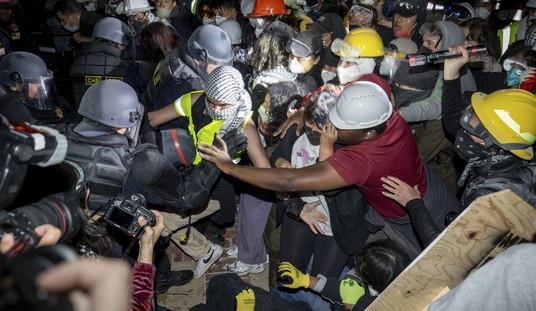Editor's note: This article originally appeared in the October issue of Townhall Magazine.
Just after 2 a.m. on May 28, 2014, the Habersham County SWAT team broke down the door of a Cornelia, Georgia home and threw a flash-bang grenade into the residence.
The device exploded in the playpen of 19-month-old Bounkham Phonesavanh, known as “Bou Bou” to his parents, severely burning the baby boy.
“It landed in his playpen and exploded on his pillow right in his face,” Alecia Phonesavanh told an Atlanta television station. “They lied to me. They kept tell- ing me my son was OK,” she said. “When I saw his playpen I just about threw up. I got really sick, I was so scared.”
Bou Bou suffered severe burns on his face and a laceration to his chest. Over the next month doctors had to repair the boy’s lungs so he could breathe without a ventilator, reattach his nose, which had been blown off during the explosion, and do extensive repair to his lips and mouth. Bou Bou can breathe and walk again, but he will need plastic surgery to repair his scars when he grows up.
For their part, the SWAT team raid was a total failure. No suspects, drugs, cash, or contraband was found in the house. The suspect named in the “no knock” warrant, who was later charged with mere possession of methamphetamine, didn’t even live at the address. He was arrested without incident at a completely different home later that day.
“This is America, and you’re sup- posed to be safe here” Bou Bou’s father, also named Bounkham, later told NBC News, “but you’re not even safe around the cops.”
GATEWAY GUNS
How did we get to this point as a country? Why are SWAT teams raiding American homes on flimsy evidence and sometimes hurting American children in the process?
The answer may begin almost 20 years earlier in Miami, Florida. On the morning of April 11, 1986, a team of FBI agents initiated a rolling stakeout of a stolen black 1979 Monte Carlo. The agents believed the driver and passenger of the car, both of whom had shot the car’s owner and left him for dead, were planning to rob a bank.
When the agents tried to stop the car and apprehend the suspects a shootout ensued. Armed with just a rifle and a shotgun, the two suspects traded approximately 145 rounds of fire with the FBI agents, killing two agents, before they were shot dead.
A later FBI investigation of the incident concluded that the agents’ deaths were partly to blame on the lack of “stopPing power” exhibited by the agents’ firearms. Citing the incident, the FBI subsequently upgraded the firepower of all their agents. And many local law enforcement agencies followed suit.
Former-Deputy Attorney General George Terwilliger, who served under President George H.W. Bush, specifically cites that Miami incident as the spark that led many local law enforcement agencies to begin to develop SWAT teams.
“It is a question of how those capabilities and the equipment that go with it are used,” Terwilliger tells Townhall, “and are they being used for a lawful and appropriate purpose. Some of that may be constitutional, but it’s more of a public policy question.”
And just four years after the Miami shootout, Congress made the public policy determination that local law enforcement agencies needed a more military grade arsenal to conduct the increasingly violent War on Drugs.
Section 1208 of the National Defense Authorization Act allowed the secretary of defense to “transfer to Federal and State agencies personal property of the Department of Defense, including small arms and ammunition, that the Secretary determines is— (A) suitable for use by such agencies in counter-drug activities; and (B) excess to the needs of the Department of Defense.”
Thus began the flow of weapons from the federal government. In 1997, Congress replaced Section 1208 with Section 1033, which is the title of the Defense Department program today. And business is booming.
According to the Defense Logistics Agency’s own website, there are more than 8,000 federal and state law enforcement agencies that have established a business relationship with the DLA through a memorandum of agreement. More military supplies, in terms of value, have been transferred to federal, local, and state law enforcement this year than any other year on record.
And since 2006, according to National Journal, the Pentagon has distributed 432 mine-resistant armored vehicles to local police departments and delivered more than 400 other armored vehicles, 500 aircraft, and 93,000 assault rifles.
And it seems most jurisdictions don’t have much of a clue how to use the equipment the military is giving them. When Redwood City, California, got a Mine-Resistant Ambush Protected vehicle from the 1033 program, San Jose Mercury News’ Bonnie Eslinger reported, “The $750,000 military vehicle Redwood City received July 1 was a gift from the federal government, according to police department officials who found themselves fielding questions about why they need such a massive vehicle.”
If police departments don’t need all this military equipment, then why are they requesting it?
“It isn’t so much that police are suddenly asking [for military surplus goods],” Defense Department spokesman Mark Wright recently told The Wall Street Journal, it’s that they realize, “‘Hey, this police force is equipped with this equipment and they got it for free.’”
DEPARTMENT OF HOMELAND SUGAR DADDY
While the DoD’s 1033 program has been around the longest, it has since been dwarfed by the Department of Homeland Security’s billions in “terrorism grants,” which are also not subject to much oversight.
In December of 2011, Andrew Becker and G.W. Schulz for the Center for Investigative Reporting found that DHS had distributed more than $34 billion in grants to local law enforcement agencies through the agency’s Homeland Security Grant Program since 2001.
Some of the equipment purchased included:
• $180,000 for two bomb-disarming robots in bomb-free Des Moines, Iowa.
A Keene, New Hampshire, city council member explained to the ACLU exactly why so many local governments are applying to the DHS program. “Our application talked about the danger of domestic terrorism, but that’s just something you put in the grant application to get the money,” he said. “What red-blooded American cop isn’t going to be excited about getting a toy like this? That’s what it comes down to.”
BOYS WITH TOYS
As taxpayers, every American should be upset with the billions of dollars that are being wasted on tanks protecting picnics in towns no terrorist has ever heard of. But Americans should also be upset with how these billions of dollars are affecting police behavior, and threatening everyone’s constitutional rights as well.
According to Dr. Peter Kraska, professor of justice studies at Eastern Kentucky University, the number of SWAT teams in small towns has risen from 20 percent in the mid-1980s to 80 percent by the mid-2000s, while 90 percent of larger cities have had SWAT units since the mid-1990s. And none of these tactical teams are just sitting around waiting for a real emergency. The number of SWAT raids has exploded from 3,000 in the mid-1980s to 45,000 by the mid-2000s.
A chilling report from the American Civil Liberties Union found that 79 percent of all SWAT raids conducted between 2011 and 2012 were to execute a search warrant for possible narcotics. Only 7 percent of those raids involved anything resembling a hostage, barricade, or active shooter situation, according to the report.
Additionally, the amount of narcotics found in the homes that did contain drugs didn’t justify the deployment of a heavily armed tactical unit at all. Local law enforcement agencies simply are not doing their due diligence when they are making their threat assessments.
The ACLU concluded, “more often than not, we found that SWAT records contained no information to explain why the officers believed a particular scenario was ‘high risk.’” Whereas virtually every situation where a SWAT team was deployed for a hostage, shooter, or barricading situation, there was detailed evidence establishing why the team was justifiably deployed. Just some of the nightmares from the ACLU report include:
• In 2008, Tarika Wilson was shot and killed holding her 14-month-old son in Lima, Ohio. The SWAT team was looking for Wilson’s boyfriend on the suspicion of drug dealing.
• In 2011, Eurie Stamp was watching a baseball game in Framingham, Massachusetts when a SWAT team busted through his door and tossed a flash-bang grenade. He complied with officers, facing down on the ground where he was shot, when one of the SWAT team’s firearms went off. They were looking for his son’s girlfriend on drug charges, but arrested her outside of his house; they decided to raid it anyway.
• Also in 2011, Jose Guerena, an Iraq War veteran, investigated what looked liked a man in the bushes outside his home at the request of his wife. He picked up his rifle to see what was the matter. The SWAT team surrounding his house fired 71 shots, hitting Guerena 22 times. He died on his kitchen floor. The police were looking for drugs; they found none in Guerena’s home.
And police are branching out from using their SWAT toys in drug raids. Libertarian journalist Radley Balko notes that poker games have become subject to SWAT team raids. SWAT units have been “sent into bars and fraternities suspected of allowing underage drinking, and even to enforce alcohol and occupational licensing regulations,” too, he wrote. Even federal agencies are getting in the game. “Earlier this year [2011], the Department of Education sent its SWAT team to the home of someone suspected of defrauding the federal student loan program.”
DEMILITARIZING AMERICA
There is a growing consensus across America that the militarization of local law enforcement has gone too far. “What we see going on in Missouri right now, for example–it’s one thing to equip police with riot gear in order to protect officers and so forth. It’s another thing to deploy military vehicles, uniforms that for all intents and purposes look like military uniforms,” Terwilliger says. “Cops need to be protected, but I think there’s at least a legitimate question as to whether or not deploying police officers in full military gear–combat military gear–invites a response that’s more dangerous to police than another approach might entail.”
But Terwilliger believes some jurisdictions do need the equipment. “Law enforcement agencies, particularly I think the sheriffs in rural areas, are facing cartels with automatic weapons and explosives literally at the fence on the other side of the border,” he explains. “Should they be equipped to be prepared to deal with the eventualities that that circumstance presents? I think the answer to that would be yes.”
But which jurisdictions should build up their military capabilities and which ones shouldn’t? Terwilliger argues that local governments should decide.
“What you raise is an issue for state and local governments who fund and control those police agencies. And the issue is how and when should ... sophisticated tactical equipment be used,” Terwilliger says. “And those decisions should be made at a state and local level. Whether because it’s there it gets overused, I can see there could be a tendency to do that, but that’s where law enforcement managers and their civilian overseers need to step in.”
The problem is that these funding decisions are not being made at the local level. It is the federal government that is encouraging local governments to spend big at federal taxpayers’ expense. Local law enforcement is getting a free ride. There is no budget constraint forcing local law enforcement to ask themselves if they really need all these cool new toys.
Some politicians have had enough of law enforcement agencies turning America into a war zone.
“Washington has incentivized the militarization of local police precincts by using federal dollars to help municipal governments build what are essentially small armies,” Sen. Rand Paul (R-KY) wrote in Time magazine after the recent riots in Ferguson, Missouri began. “Police departments,” Rand wrote, are competing “to acquire military gear that goes far beyond what most of Americans think of as law enforcement.”
UNDERMINING THE RULE OF LAW
Growing up, my parents told me to respect and trust the police; they’re the good guys. Their dedication to public safety is glorified in popular culture, with shows like “COPS,” “T.J. Hooker,” “CHiPS,” and “Law and Order: Special Victims Unit.”
But in the post-9/11 world, thanks to the federal government, the good-natured cop, like the one Erik Estrada personified, is dead. We no longer see cop cars; we see tanks. We see police utilizing military-grade weapons, some of which are wholly inappropriate for civilian policing. We hear about raids where full-blown tactical units are deployed in situations that don’t warrant such a show of force.
If we want the next generation of Americans to respect and honor the rule of law, we need to start right-sizing our local law enforcement agencies. And getting the federal government out of the local safety grant business would be a great place to start. •
























Join the conversation as a VIP Member